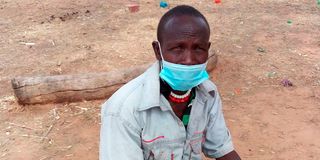Breaking News: Old Kijabe dam tragedy: Death toll rises to 45
Ignorance blamed for rising cases of Kala-azar in West Pokot

Ritanyang Domokit, who has Kala- azar, at Kacheliba treatment center.
What you need to know:
- Kala-azar is a vector-borne infectious disease that is transmitted to humans by infected sandflies and is the second-largest parasitic killer in the world after malaria.
- If left untreated, most cases result in death within two–three years of clinical manifestation.
West Pokot County is still recording rising cases of Kala azar and Mycetoma even as experts raise concern about lack of awareness among residents.
The experts cite considerable knowledge gap regarding neglected tropical diseases (NTDs) , which have continued to ravage hundreds of residents mainly in dry pastoral areas.
According to a report from the Ministry of Health, more than 600 people from West Pokot County contract Kala azar every year.
Kala azar is a vector-borne infectious disease that is transmitted to humans by infected sandflies and is the second-largest parasitic killer in the world after malaria. If left untreated, most cases result in death within two–three years of clinical manifestation. The disease affects some of the world’s poorest people and is associated with malnutrition, population displacement, poor housing, a weak immune system and lack of financial resources, according to the World Health Organization..
Dr Chege Kimani, a medical superintendent at Kacheliba Sub-county Hospital that deals with Kala azar, noted that they treated 670 patients last year.
“This year we have already clocked 500 cases. The burden of this disease is still heavy,” he said, noting that most residents lack awareness of the life-threatening disease. He emphasised the need for organising sensitisation programmes in villages as regards to the cause, transmission and prevention.
“West Pokot has the highest number of Kala azar cases. People need to test on time. We also need to have entomologists and control sand flies,” he said.
Dr Njenga noted that the disease has signs and symptoms similar to those of malaria including headache, fever, vomiting, lack of appetite and general body weakness. Two months ago, residents in Kacheliba benefited from a free medical camp for NTDs organised by the Drugs for Neglected Diseases initiative (DNDi), a research organisation, in partnership with Rotary International and the county government.
John Lotodo, West Pokot County coordinator for NTDs, said they have trained 150 health care workers to move within the county and administer medication to patients.
“The most affected areas are Lomut, Masol, Sekerr, Kasei, Alale and Ombolion. Sigor Sub-county Hospital was established as a treatment site. We need Sh5 million to set up another treatment site in Kacheliba,” he said.
Susan Kodereng, whose 20-year old daughter tested positive for Mycetomia during the medical camp, said she had suffered for five years without treatment.“The wound started like an injury but at some point it started oozing purse.
“I thank DNDI for the medical camp. I had sold a goat to have my daughter treated but the wound kept increasing in size. At first doctors thought it was tetanus,” she said.
DNDI’s Head of Mycetoma Disease, Dr Borna Nyaoke, noted that Mycetoma is a neglected disease that appears in one foot but can also affect any other part of the body. She regretted that many patients don’t know if they have the disease.
She said despite the progress made so far, 50 per cent of patients do not have access to appropriate diagnosis and treatment.
DNDI Executive Director Luis Pizarro said they aim to raise awareness about neglected diseases. “There are gaps and we need new tools for many neglected diseases,” he said.





